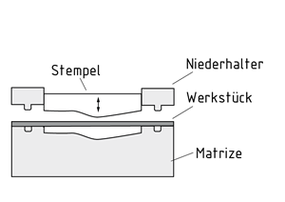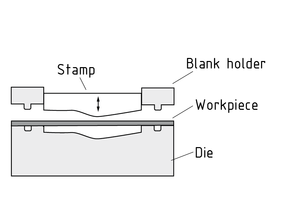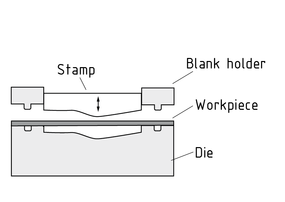
Choose one
or multiple languages
0,1,1
- German
- English
- Chinese
- Spanish
Stretch forming

Stretch-Forming is a tensile shaping process for large, flat components.
During simple stretch forming, sheet metal blanks are clamped on two or four sides between gripping jaws. A vertically moving stamp shapes the sheet. However, Friction between the component and stamp hinders uniform stretching in the component.
Uniform stretching can be achieved with tangential stretch forming, in which the workpiece is pre-tensioned and stretched to its yield point. In this case, the sheet is positioned against the stamp using collet chucks. This process involves tensile and Bending deformation.
During Cyril Bath stretch forming, the collet chucks can be moved horizontally as well as vertically. The middle part of the workpiece can be shaped more extensively and better cold Hardening achieved. The high cold hardening coefficient enables uniform shaping and prevents cracks.
Small drawing depths in stretch forming are often supplemented by Deep-drawing.
Streckziehen

Streckziehen ist ein Zugumformverfahren für große, flache Teile.
Beim einfachen Streckziehen werden Blechplatinen zwischen Klemmvorrichtungen zweiseitig oder vierseitig eingespannt. Ein vertikal verfahrbarer Stempel formt das Blech um. Reibung zwischen Bauteil und Stempel verhindern jedoch eine gleichmäßige Dehnung des Bauteils.
Gleichmäßige Dehnung kann beim Tangentialstreckziehen erreicht werden, bei dem das Werkstück vorgespannt und zur Fließgrenze gestreckt wird. Dabei wird das Blech mit Spannzangen an den Stempel angelegt. Das Verfahren besteht so aus einer Zug- und einer Biegeumformung.
Beim Cyril-Bath-Verfahren sind die Spannzangen sowohl vertikal als auch horizontal verfahrbar. Der Mittelteil des Werkstücks kann stärker verformt und eine bessere Kaltverfestigung erreicht werden. Der hohe Verfestigungsexponent ermöglicht gleichmäßige Formänderungen und vermeidet Reißer.
Geringe Ziehtiefen beim Streckziehen werden oft durch Tiefziehen ergänzt.
拉伸成型

拉伸成型是一种用于大型平面部件的。
简单的拉伸成型工艺中,板状金属毛坯的两个或四个侧面被夹在夹爪之间。一个垂直运动的冲头对板材进行造型。但是,部件和冲头之间的摩擦阻碍了部件的均匀拉伸。
切向拉伸成型可以实现均匀拉伸,其中工件预张紧后被拉伸到其屈服点。在这种情况下,使用套爪卡盘将片材定位到冲头对面。这个过程中发生拉伸和弯曲变形。
Cyril Bath 拉伸成型工艺中,套爪卡盘既可以水平移动又可以垂直移动。工件的中间部分可定型范围更大,冷硬化效果更好。冷加工硬化系数确保了成型均匀且不产生裂缝。
拉伸成型工艺中小的拉伸深度通常通过补偿。
简单的拉伸成型
Conformado por estirado

El conformado por estirado es un para componentes grandes y planos.
Durante el conformado por estirado simple, las láminas de metal son sujetadas por dos o cuatro lados entre las quijadas de sujeción. Un estampador de movimiento vertical le da forma a la lámina. Sin embargo, la fricción entre el componente y el estampador impide el estiramiento uniforme del componente.
El estiramiento uniforme puede lograrse con un conformado por estiramiento tangencial, en el cual la pieza de trabajo es pretensada y estirada hasta su punto de fluencia. En este caso, la lámina es colocada contra el estampador mediante mandriles de pinza. Este proceso involucra la deformación a tensión y la flexión.
Durante el conformado por estiramiento tipo Cyril Bath, los mandriles de pinza pueden ser movidos tanto horizontal como verticalmente. La parte media de la pieza de trabajo puede ser conformada aún más y lograr un mejor endurecimiento frío. El alto coeficiente de endurecimiento frío permite un conformado uniforme y previene el agrietamiento.
Las pequeñas profundidades de embutido en el conformado por estirado se complementan a menudo con el .
Conformado por estirado simple
